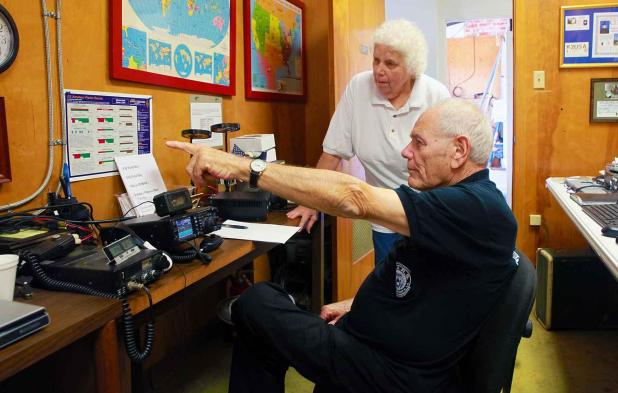
Mel Simon points to the amateur radio transceiver's antenna connection while Jackie Price looks on. They're members of the Bayouland Emergency Amateur Radio Service, which took part in the national ham radio Field Day on Saturday and Sunday.

Roland Verret shows the Vibroplex Morse Code key he has kept since working as a railroad telegrapher in the 1960s.
From the Editor: Ham radio operators take part in nationwide contest
On the second floor of the old Whitney Bank building on Everett Street, Mel Simon was trying to figure out what was wrong.
When the Yaesu amateur radio transceiver in front of him was connected by cable to a roof-mounted dipole antenna, basically a horizontal wire, everything seemed to be working. But the 40-meter band, usually a workhorse for radio amateurs, was oddly quiet.
So Simon connected the transceiver to a cable that led to a tri-bander beam antenna, something like a traditional TV aerial, also mounted on the roof. Now the standing wave ratio, a measure of the electrical load presented to the radio by the transmission line and the antenna, was off the charts for 20 meters, another set of frequencies amateurs use often.
If the SWR is too high, the antenna is inefficient, and radio energy may come back into the transceiver. So the transceiver reduces its power to protect itself. Simon saw that the radio’s SWR meter said “infinity.” No signal could go out.
“Field Day is all about finding out what’s wrong with your station,” said Jackie Price, president of the Bayouland Emergency Amateur Radio Service.
“That’s what we did today,” Simon said.
The problem turned out to be a short somewhere in the transmission line, a stouter version of the coaxial cable used for television, or the antenna. It will require some exploring to track down.
BEARS took part in Saturday and Sunday’s annual Field Day sanctioned by the American Amateur Radio League, the national association for radio hams. It’s part contest, trying to see which club or individual can contact the most stations, and part preparation for a time when amateurs can put their equipment and expertise to work in an emergency.
“So whenever we have hurricanes,” Simon said, “you volunteer your radio and go where they tell you.”
That’s one of the reasons the Federal Communications Commission continues to set aside portions of valuable radio spectrum for use by amateurs who have passed one of three levels of testing to get federal licenses. There are other reasons, too.
“Amateurs are responsible for a lot of innovation, although not so much anymore,” Simon said. “And there was a pool of radio operators.”
Simon, who lives in New Iberia, got started in amateur radio back in high school. A friend with whom he often went on double dates suggested they ditch their dates one evening and visit a local priest who had a radio setup that could contact the world. Simon was hooked.
In the best tradition of the hobby, he built some of his own equipment and bought more. He still enjoys making contacts by RTTY, or radio teletype; voice; and CW, which is ham talk for communicating over the radio with Morse code.
Morse code came up again when Roland Verret, who has the same name as a St. Mary Parish School Board member, dropped by the BEARS headquarters.
Verret, who lives in Berwick, was a depot agent for the Central of Georgia Railroad in Macon during the 1960s. On Saturday, Verret arrived with a keepsake from the long days when he copied orders for the trains in Morse code.
The keepsake is a Vibroplex telegraph key, stored in a dark carrying case that shows its age. The Vibroplex is a “bug,” a kind of key that makes dits and dahs by pushing paddles back and forth, rather than pounding a key up and down as with a traditional straight key. A bug causes less fatigue and, more importantly, it’s faster.
Verret had to listen to, decode and type code at 35 words per minute to graduate from telegraphy school in Iowa. Before the FCC did away with the Morse code requirement for hams, 13 words per minute was enough to earn a General-class license.
Verret bought the bug for $100. He quit the railroad job after 4½ years, tired of the seven-day work weeks, and packed away his bug.
He wanted to offer the Vibroplex to the BEARS club, but the half-dozen members at Saturday’s Field Day told him he should keep it. The bug would be worth much more now.
Verret said he set out to accomplish three things in his life: to scuba dive, to become a pilot and to learn karate. He did all three, but age (he’s 77) and health keep him from doing those things.
So he thought he might reconnect with Morse code by checking out amateur radio.
It’s just as well that he’s hanging on to the bug.
Bill Decker is managing editor of The Daily Review.
